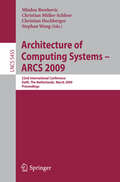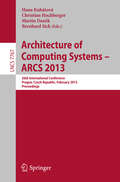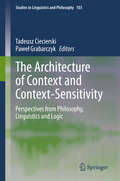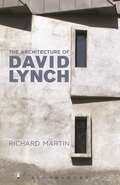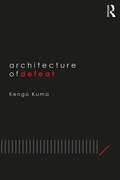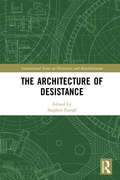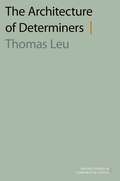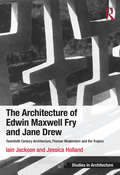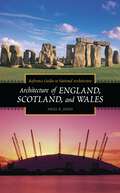- Table View
- List View
Architecture of Computing Systems - ARCS 2009: 22nd International Conference, Delft, The Netherlands, March 10-13, 2009, Proceedings (Lecture Notes in Computer Science #5455)
by Christian Hochberger Stephan Wong Mladen Berekovic Christian Müller-SchloerThis book constitutes the refereed proceedings of the 22nd International Conference on Architecture of Computing Systems, ARCS 2009, held in Delft, The Netherlands, in March 2009. The 21 revised full papers presented together with 3 keynote papers were carefully reviewed and selected from 57 submissions. This year's special focus is set on energy awareness. The papers are organized in topical sections on compilation technologies, reconfigurable hardware and applications, massive parallel architectures, organic computing, memory architectures, enery awareness, Java processing, and chip-level multiprocessing.
Architecture of Computing Systems - ARCS 2010: 23rd International Conference, Hannover, Germany, February 22-25, 2010, Proceedings (Lecture Notes in Computer Science #5974)
by Christian Müller-Schloer Wolfgang Karl Sami YehiaArchitecture of Computing Systems - ARCS 2011: 24th International Conference, Lake Como, Italy, February 24-25, 2011. Proceedings (Lecture Notes in Computer Science #6566)
by Mladen Berekovic William Fornaciari Uwe Brinkschulte Cristina SilvanoThis book constitutes the refereed proceedings of the 24th International Conference on Architecture of Computing Systems, ARCS 2011, held in Lake Como, Italy, in February 2011. The 22 revised full papers presented in seven technical sessions were carefully reviewed and selected from 62 submissions. The papers are organized in topical sections on customization and application specific accelerators; multi/many-core architectures; adaptive system architectures; processor architectures; memory architectures optimization; organic and autonomic computing; network-on-chip architectures.
Architecture of Computing Systems - ARCS 2012: 25th International Conference, Munich, Germany, February 28 - March 2, 2012. Proceedings (Lecture Notes in Computer Science #7179)
by Andreas Herkersdorf Kay Römer Uwe BrinkschulteThis book constitutes the refereed proceedings of the 25th International Conference on Architecture of Computing Systems, ARCS 2012, held in Munich, Germany, in February/March 2012. The 20 revised full papers presented in 7 technical sessions were carefully reviewed and selected from 65 submissions. The papers are organized in topical sections on robustness and fault tolerance, power-aware processing, parallel processing, processor cores, optimization, and communication and memory.
Architecture of Computing Systems -- ARCS 2013: 26th International Conference, Prague, Czech Republic, February 19-22, 2013 Proceedings (Lecture Notes in Computer Science #7767)
by Martin Dan 283 K Bernhard Sick Hana Kubatova Christian HochbergerThis book constitutes the refereed proceedings of the 26th International Conference on Architecture of Computing Systems, ARCS 2013, held in Prague, Czech Republic, in February 2013. The 29 papers presented were carefully reviewed and selected from 73 submissions. The topics covered are computer architecture topics such as multi-cores, memory systems, and parallel computing, adaptive system architectures such as reconfigurable systems in hardware and software, customization and application specific accelerators in heterogeneous architectures, organic and autonomic computing including both theoretical and practical results on self-organization, self-configuration, self-optimization, self-healing, and self-protection techniques, operating systems including but not limited to scheduling, memory management, power management, RTOS, energy-awareness, and green computing.
Architecture of Computing Systems -- ARCS 2014: 27th International Conference, Lübeck, Germany, February 25-28, 2014, Proceedings (Lecture Notes in Computer Science #8350)
by Erik Maehle Kay Römer Wolfgang Karl Eduardo TovarThis book constitutes the proceedings of the 27th International Conference on Architecture of Computing Systems, ARCS 2014, held in Lübeck, Germany, in February 2014. The 20 papers presented in this volume were carefully reviewed and selected from 44 submissions. They are organized in topical sections named: parallelization: applications and methods; self-organization and trust; system design; system design and sensor systems; and virtualization: I/O, memory, cloud; dependability: safety, security, and reliability aspects.
Architecture of Computing Systems -- ARCS 2016: 29th International Conference, Nuremberg, Germany, April 4-7, 2016, Proceedings (Lecture Notes in Computer Science #9637)
by Frank Hannig João M. P. Cardoso Thilo Pionteck Dietmar Fey Wolfgang Schröder-Preikschat Jürgen TeichThis book constitutes the proceedings of the 29th International Conference on Architecture of Computing Systems, ARCS 2016, held in Nuremberg, Germany, in April 2016. The 29 full papers presented in this volume were carefully reviewed and selected from 87 submissions. They were organized in topical sections named: configurable and in-memory accelerators; network-on-chip and secure computing architectures; cache architectures and protocols; mapping of applications on heterogeneous architectures and real-time tasks on multiprocessors; all about time: timing, tracing, and performance modeling; approximate and energy-efficient computing; allocation: from memories to FPGA hardware modules; organic computing systems; and reliability aspects in NoCs, caches, and GPUs.
Architecture of Computing Systems - ARCS 2017: 30th International Conference, Vienna, Austria, April 3–6, 2017, Proceedings (Lecture Notes in Computer Science #10172)
by Jens Knoop Wolfgang Karl Martin Schulz Koji Inoue Thilo PionteckThis book constitutes the proceedings of the 30th International Conference on Architecture of Computing Systems, ARCS 2017, held in Vienna, Austria, in April 2017. The 19 full papers presented in this volume were carefully reviewed and selected from 42 submissions. They were organized in topical sections entitled: resilience; accelerators; performance; memory systems; parallelism and many-core; scheduling; power/energy.
The Architecture of Constitutional Amendments: History, Law, Politics
by Richard AlbertThis innovative book blends constitutional theory with real-life political practice to explore the impact of codifying constitutional amendments on the operation of the constitution in relation to democracy, the rule of law, and the separation of powers. It draws from comparative, historical, political and theoretical perspectives to answer questions all constitutional designers should ask themselves:- Should the constitution append amendments sequentially to the end of the text?- Should it embed amendments directly into the existing text, with notations about what has been modified and how? - Should it instead insert amendments into the text without indicating at all that any alteration has occurred? The book examines the 3 major models of amendment codification – the appendative, the integrative, and the invisible models – and also shows how some jurisdictions have innovated alternative forms of amendment codification that combine elements of more than 1 model in a unique hybridisation driven by history, law, and politics.Constitutional designers rarely consider where in the constitution to codify amendments once they are ratified. Yet this choice is pivotal to the operation of any constitution. This groundbreaking book shows why the placement of constitutional amendments goes well beyond mere aesthetics. It influences how and whether a people remembers its past, how the constitutional text will be interpreted and by whom, and whether the constitution will be easily accessible to the governed.A global tour of the high stakes of constitution-making, this book features 18 diverse and outstanding scholars from around the world – across Africa, America, Asia and Oceania, and Europe – raising new questions, opening our eyes to new streams of research, and uncovering new possibilities for constitutional design.
The Architecture of Constitutional Amendments: History, Law, Politics
This innovative book blends constitutional theory with real-life political practice to explore the impact of codifying constitutional amendments on the operation of the constitution in relation to democracy, the rule of law, and the separation of powers. It draws from comparative, historical, political and theoretical perspectives to answer questions all constitutional designers should ask themselves:- Should the constitution append amendments sequentially to the end of the text?- Should it embed amendments directly into the existing text, with notations about what has been modified and how? - Should it instead insert amendments into the text without indicating at all that any alteration has occurred? The book examines the 3 major models of amendment codification – the appendative, the integrative, and the invisible models – and also shows how some jurisdictions have innovated alternative forms of amendment codification that combine elements of more than 1 model in a unique hybridisation driven by history, law, and politics.Constitutional designers rarely consider where in the constitution to codify amendments once they are ratified. Yet this choice is pivotal to the operation of any constitution. This groundbreaking book shows why the placement of constitutional amendments goes well beyond mere aesthetics. It influences how and whether a people remembers its past, how the constitutional text will be interpreted and by whom, and whether the constitution will be easily accessible to the governed.A global tour of the high stakes of constitution-making, this book features 18 diverse and outstanding scholars from around the world – across Africa, America, Asia and Oceania, and Europe – raising new questions, opening our eyes to new streams of research, and uncovering new possibilities for constitutional design.
The Architecture of Context and Context-Sensitivity: Perspectives from Philosophy, Linguistics and Logic (Studies in Linguistics and Philosophy #103)
by Tadeusz Ciecierski Paweł GrabarczykThis volume addresses foundational issues of context-dependence and indexicality, which are at the center of the current debate within the philosophy of language. Topics include the scope of context-dependency, the nature of content and the character of input data of cognitive processes relevant for the interpretation of utterances. There's also coverage of the role of beliefs and intentions as contextual factors, as well as the validity of arguments in context-sensitive languages.The contributions consider foundational issues regarding context-sensitivity from three different, yet related, perspectives on the phenomenon of context-dependence: representational, structural, and functional. The contributors not only address the representational, structural and/or functional problems separately but also study their mutual connections, thus furthering the debate and bringing competing approaches closer to unification and consensus. This text appeals to students and researchers within the field.This is a very useful collection of essays devoted to the roles of context in the study of language. Its essays provide a useful overview of the current debates on this topic, and they put forth novel contributions that will undoubtedly be of relevance for the development of all areas in philosophy and linguistics interested in the notion of context. Stefano Predelli Department of Philosophy, University of Nottingham, Nottingham, UK
The Architecture of David Lynch
by Richard MartinFrom the Red Room in Twin Peaks to Club Silencio in Mulholland Drive, the work of David Lynch contains some of the most remarkable spaces in contemporary culture. Richard Martin's compelling study is the first sustained critical assessment of the role architecture and design play in Lynch's films. Martin combines original research at Lynchian locations in Los Angeles, London and Lódz with insights from architects including Adolf Loos, Le Corbusier and Jean Nouvel and urban theorists such as Jane Jacobs and Edward Soja. In analyzing the towns, cities, homes, roads and stages found in Lynch's work, Martin not only reveals their central importance for understanding this controversial and distinctive film-maker,but also suggests how Lynch's films can provide a deeper understanding of the places and spaces in which we live.
The Architecture of David Lynch
by Richard MartinFrom the Red Room in Twin Peaks to Club Silencio in Mulholland Drive, the work of David Lynch contains some of the most remarkable spaces in contemporary culture. Richard Martin's compelling study is the first sustained critical assessment of the role architecture and design play in Lynch's films. Martin combines original research at Lynchian locations in Los Angeles, London and Lódz with insights from architects including Adolf Loos, Le Corbusier and Jean Nouvel and urban theorists such as Jane Jacobs and Edward Soja. In analyzing the towns, cities, homes, roads and stages found in Lynch's work, Martin not only reveals their central importance for understanding this controversial and distinctive film-maker,but also suggests how Lynch's films can provide a deeper understanding of the places and spaces in which we live.
Architecture of Defeat
by Kengo KumaKengo Kuma, one of Japan’s leading architects, has been combining professional practice and academia for most of his career. In addition to creating many internationally recognized buildings all over the world, he has written extensively about the history and theory of architecture. Like his built work, his writings also reflect his profound personal philosophy. Architecture of Defeat is no exception. Now available in English for the first time, the book explores events and architectural trends in the twentieth and twenty-first centuries in both Japan and beyond. It brings together a collection of essays which Kuma wrote after disasters such as the destruction of the World Trade Center in New York City on 9/11 and the earthquake and tsunami that obliterated much of the built landscape on Japan’s northern shore in a matter of minutes in 2011. Asking if we have been building in a manner that is too self-confident or arrogant, he examines architecture’s intrinsic—and often problematic—relationship to the powerful forces of contemporary politics, economics, consumerism, and technology, as well as its vital ties to society. Despite the title, Architecture of Defeat is an optimistic and hopeful book. Rather than anticipating the demise of architecture, Kuma envisages a different mode of conceiving architecture: guided and shaped by more modesty and with greater respect for the forces of our natural world. Beautifully designed and illustrated, this is a fascinating insight into the thinking of one of the world’s most influential architects.
Architecture of Defeat
by Kengo KumaKengo Kuma, one of Japan’s leading architects, has been combining professional practice and academia for most of his career. In addition to creating many internationally recognized buildings all over the world, he has written extensively about the history and theory of architecture. Like his built work, his writings also reflect his profound personal philosophy. Architecture of Defeat is no exception. Now available in English for the first time, the book explores events and architectural trends in the twentieth and twenty-first centuries in both Japan and beyond. It brings together a collection of essays which Kuma wrote after disasters such as the destruction of the World Trade Center in New York City on 9/11 and the earthquake and tsunami that obliterated much of the built landscape on Japan’s northern shore in a matter of minutes in 2011. Asking if we have been building in a manner that is too self-confident or arrogant, he examines architecture’s intrinsic—and often problematic—relationship to the powerful forces of contemporary politics, economics, consumerism, and technology, as well as its vital ties to society. Despite the title, Architecture of Defeat is an optimistic and hopeful book. Rather than anticipating the demise of architecture, Kuma envisages a different mode of conceiving architecture: guided and shaped by more modesty and with greater respect for the forces of our natural world. Beautifully designed and illustrated, this is a fascinating insight into the thinking of one of the world’s most influential architects.
The Architecture of Desire (Rat Lords #2)
by Mary GentleMercenaries in lace and steel roam the countryside and the heads of criminals are impaled on London Bridge. The characters' relationships are played out in the shadow of the hangman's rope. Sequel to Rats and Gargoyles.
The Architecture of Desistance (International Series on Desistance and Rehabilitation)
by Stephen FarrallThe volume of studies into desistance has grown dramatically in recent years. Much of this research has focused on the internal dynamics of desistance such as decision-making, choice and restraint. Bringing together leading figures and drawing upon case studies from around the world, this book seeks to fill a vacuum in the contemporary literature on desistance by considering processes and practices at a societal level that influence how and why people desist from crime. Beginning with an outline of what is known about how social, cultural and economic structures shape desistance from crime, this book proceeds to explore studies of desistance in countries such as the UK, Brazil, France, Israel, Ireland, Sweden and Chile. These studies touch on variations by ethnicity, the nature of the criminal justice system, economic cycles, gender, religious belief systems and the use of time and space. Policy matters relating to desistance such as the rehabilitation and supervision of former offenders are also explored. This book will be invaluable reading to students and scholars of criminology, sociology and social studies engaged in studies of desistance, criminology, criminal justice, victimology, penology and probation.
The Architecture of Desistance (International Series on Desistance and Rehabilitation)
by Stephen FarrallThe volume of studies into desistance has grown dramatically in recent years. Much of this research has focused on the internal dynamics of desistance such as decision-making, choice and restraint. Bringing together leading figures and drawing upon case studies from around the world, this book seeks to fill a vacuum in the contemporary literature on desistance by considering processes and practices at a societal level that influence how and why people desist from crime. Beginning with an outline of what is known about how social, cultural and economic structures shape desistance from crime, this book proceeds to explore studies of desistance in countries such as the UK, Brazil, France, Israel, Ireland, Sweden and Chile. These studies touch on variations by ethnicity, the nature of the criminal justice system, economic cycles, gender, religious belief systems and the use of time and space. Policy matters relating to desistance such as the rehabilitation and supervision of former offenders are also explored. This book will be invaluable reading to students and scholars of criminology, sociology and social studies engaged in studies of desistance, criminology, criminal justice, victimology, penology and probation.
The Architecture of Determiners (Oxford Studies in Comparative Syntax)
by Thomas LeuWork in morphology is typically concerned with productive word formation and regular inflection, in any event with open class categories such as verbs, nouns, and adjectives, and their various forms. The Architecture of Determiners, by contrast, is devoted to a set of function words: the closed class of determiners. While it is traditionally assumed that function words are syntactically atomic, Thomas Leu shows that a comparative perspective on a series of determiners - each insistently vivisected into its minimal morphotactic segments - reveals an anatomy with properties analogous to clausal syntax, including a lexical, an inflectional, and left peripheral layer, as well as transformational relations among subconstituents. Leu argues that determiners are extended adjectival projections with a closed class minimal stem. Leu focuses on Swiss German and German, using other Germanic and non-Germanic languages as a comparative domain. His discussion of the internal structure of determiners includes demonstratives (ch.2), distributive quantifiers (ch.4), possessive and negative determiners (ch.5), and interrogative determiners such as 'was für' (ch.6). His main claim - that all of these involve extended adjectival projections - connects naturally to a discussion of adjectival / determiner inflection in German. Chapter 3 addresses the oft-debated strong versus weak agreement alternation in a novel way, proposing that the adjective moves within its own extended projection, in a way akin to verb movement to C in the clause. This accounts for the central facts of nominative and accusative inflection. Chapter 7, then, addresses dative and genitive morphology, setting them syntactically apart from adjectival / determiner inflection in a way that leads to a surprising account of most of the systematic (meta-) syncretism patterns in German adjectival inflection.
The Architecture of Edwin Maxwell Fry and Jane Drew: Twentieth Century Architecture, Pioneer Modernism and the Tropics (Ashgate Studies in Architecture)
by Iain Jackson Jessica HollandMaxwell Fry and Jane Drew were pioneers of Modern Architecture in Britain and its former colonies from the late 1920s through to the early 1970s. As a barometer of twentieth century architecture, their work traces the major cultural developments of that century from the development of modernism, its spread into the late-colonial arena and finally, to its re-evaluation that resulted in a more expressive, formalist approach in the post-war era. This book thoroughly examines Fry and Drew's highly influential 'Tropical Architecture' in West Africa and India, whilst also discussing their British work, such as their post World War II projects for the Festival of Britain, Harlow New Town, Pilkington Brothers’ Headquarters and Coychurch Crematorium. It highlights the collaborative nature of Fry and Drew's work, including schemes undertaken with Elizabeth Denby, Walter Gropius, Denys Lasdun, Pierre Jeanneret and Le Corbusier. Positioning their architecture, writing and educational endeavours within a wider context, this book illustrates the significant artistic and cultural contributions made by Fry and Drew throughout their lengthy careers.
The Architecture of Edwin Maxwell Fry and Jane Drew: Twentieth Century Architecture, Pioneer Modernism and the Tropics (Ashgate Studies in Architecture)
by Iain Jackson Jessica HollandMaxwell Fry and Jane Drew were pioneers of Modern Architecture in Britain and its former colonies from the late 1920s through to the early 1970s. As a barometer of twentieth century architecture, their work traces the major cultural developments of that century from the development of modernism, its spread into the late-colonial arena and finally, to its re-evaluation that resulted in a more expressive, formalist approach in the post-war era. This book thoroughly examines Fry and Drew's highly influential 'Tropical Architecture' in West Africa and India, whilst also discussing their British work, such as their post World War II projects for the Festival of Britain, Harlow New Town, Pilkington Brothers’ Headquarters and Coychurch Crematorium. It highlights the collaborative nature of Fry and Drew's work, including schemes undertaken with Elizabeth Denby, Walter Gropius, Denys Lasdun, Pierre Jeanneret and Le Corbusier. Positioning their architecture, writing and educational endeavours within a wider context, this book illustrates the significant artistic and cultural contributions made by Fry and Drew throughout their lengthy careers.
Architecture of England, Scotland, and Wales (Reference Guides to National Architecture)
by Nigel R. JonesThe British terrain is a gold mine for the student of architecture. Ranging in era from ancient times to the present day—from Stonehenge to the Millennium Dome—this volume's 76 entries include palaces, castles, bridges, churches, country houses, and various public buildings and monuments, as well as such well-known features of British architecture and design as terraced houses, suburban semi-detached houses, and public telephone kiosks. Detailed yet accessible to nonspecialist readers, the alphabetical entries also provide cross-references and lists of additional information sources in both print and electronic formats. Appendixes list the entries by location, architectural style, and architect/designer; explain the defining characteristics of major British architectural styles; and discuss the importance of the Crown, peerage, and Parliament in British architectural history. Besides a detailed subject index, the volume includes a timeline, a general bibliography, a glossary of architectural terms, and an introduction that traces the development of British architecture from prehistoric and Roman times to the 21st century.Written by an associate professor of architecture at Oklahoma State University, Architecture of England, Scotland, and Wales, part of Greenwood's Reference Guides to National Architecture series, presents architectural biographies of these countries' most famous and significant structures.
The Architecture of Ethics
by Thomas FisherEthics is one of the most important and least understood aspects of design practice. In his latest book, Thomas Fisher shows how ethics are inherent to the making of architecture – and how architecture offers an unusual and useful way of looking at ethics. The Architecture of Ethics helps students in architecture and other design disciplines to understand the major approaches to ethics and to apply them to the daily challenges they face in their work. The book covers each of the four dominant approaches to ethics: virtue ethics, social contract ethics, duty ethics, and utilitarian ethics. Each chapter examines the dilemmas designers face from the perspective of one of these categories. Written in an accessible, jargon-free style, the text also features 100 illustrations to help integrate these concepts into the design process and to support visual understanding. Ethics is now a required part of accredited architecture programs, making this book essential reading for all students in architecture and design.
The Architecture of Ethics
by Thomas FisherEthics is one of the most important and least understood aspects of design practice. In his latest book, Thomas Fisher shows how ethics are inherent to the making of architecture – and how architecture offers an unusual and useful way of looking at ethics. The Architecture of Ethics helps students in architecture and other design disciplines to understand the major approaches to ethics and to apply them to the daily challenges they face in their work. The book covers each of the four dominant approaches to ethics: virtue ethics, social contract ethics, duty ethics, and utilitarian ethics. Each chapter examines the dilemmas designers face from the perspective of one of these categories. Written in an accessible, jargon-free style, the text also features 100 illustrations to help integrate these concepts into the design process and to support visual understanding. Ethics is now a required part of accredited architecture programs, making this book essential reading for all students in architecture and design.
Architecture of First Societies: A Global Perspective
by Mark M. Jarzombek“This book is the most comprehensively global and critically sensitive synthesis of what we now know of the material and socio-cultural evolution of the so-called First Societies. Written by a distinguished architectural historian and theorist, this truly remarkable and indispensable study shows how the material culture of our forebears, from building to clothing, food, ritual and dance, was inextricably bound up with the mode of survival obtained in a particular place and time…It is a study that will surely become required reading for every student of material culture.”—Kenneth Frampton Starting with the dawn of human society, through early civilizations, to the pre-Columbian American tribes, Architecture of First Societies: A Global Perspective traces the different cultural formations that developed in various places throughout the world to form the built environment. Looking through the lens of both time and geography, the history of early architecture is brought to life with full-color photographs, maps, and drawings. Drawing on the latest research in archaeological and anthropological knowledge, this landmark book also looks at how indigenous societies build today in order to help inform the past.
